NLP BASELINE
Summary for application and theory for NLP baseline model. Sample code please referred to My github.
Even we do not use them today, however, learning the baseline models are important for understanding on how to encode and decode a language, which is the priority of NLP.
Logistic Regression
STEPS
1. Preprocessing
Stop words and punctuation
Stemming and lowercasing
Tokenize sentences
2. Feature Extraction with frequency
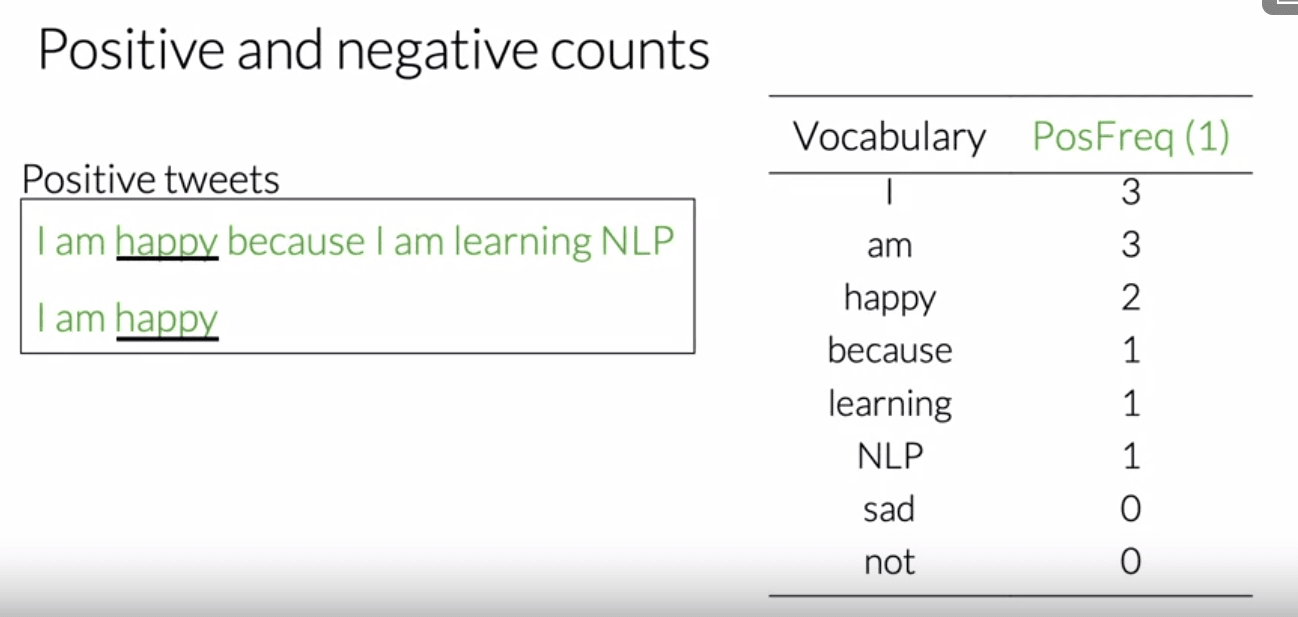

the sum is for unique words, do duplicate.
3. Train Logistic model for sentiment analysis based on the features
Naive Bayes
Steps
1. Get or annotate a dataset with positive and negative tweets
2. Preprocess tweet
3. Get Word count
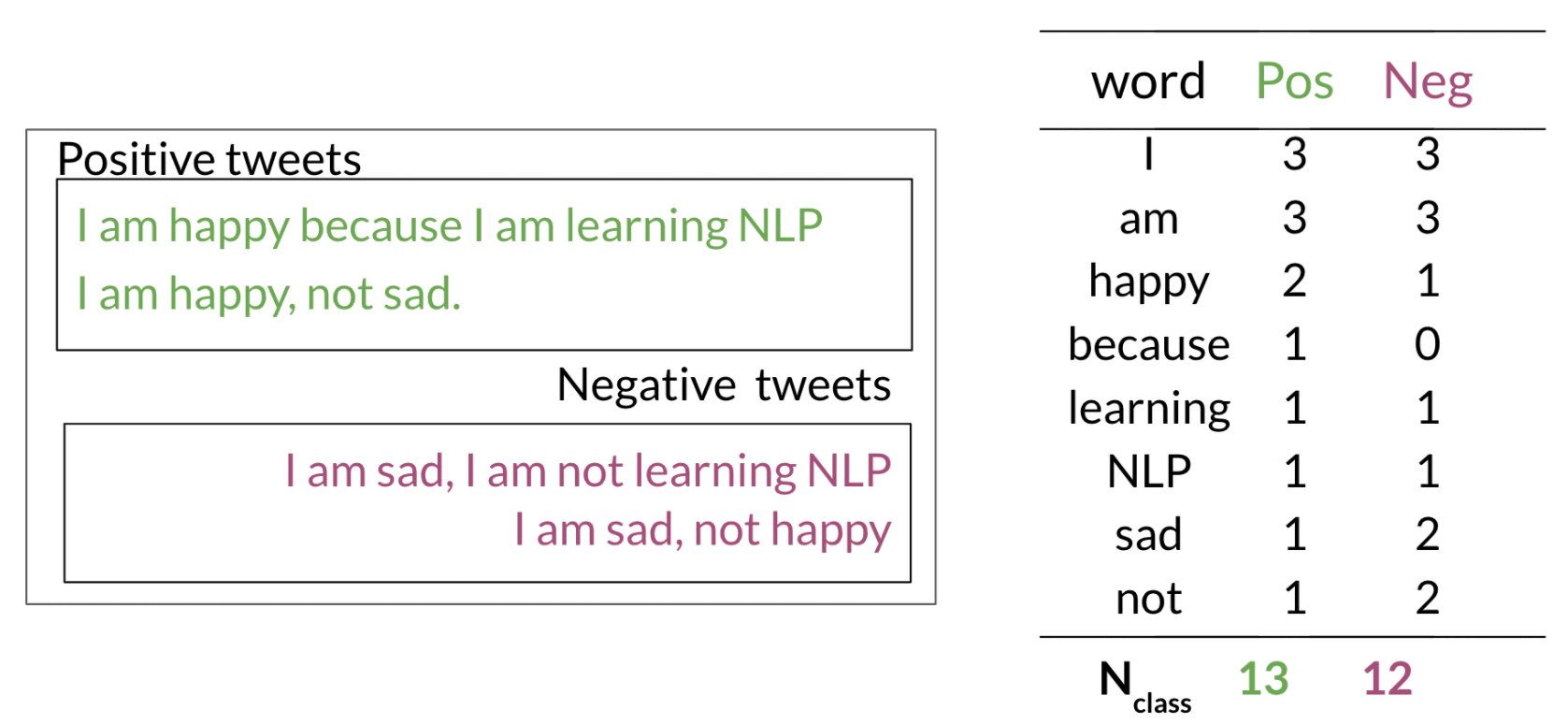
4. Get Frequency tables
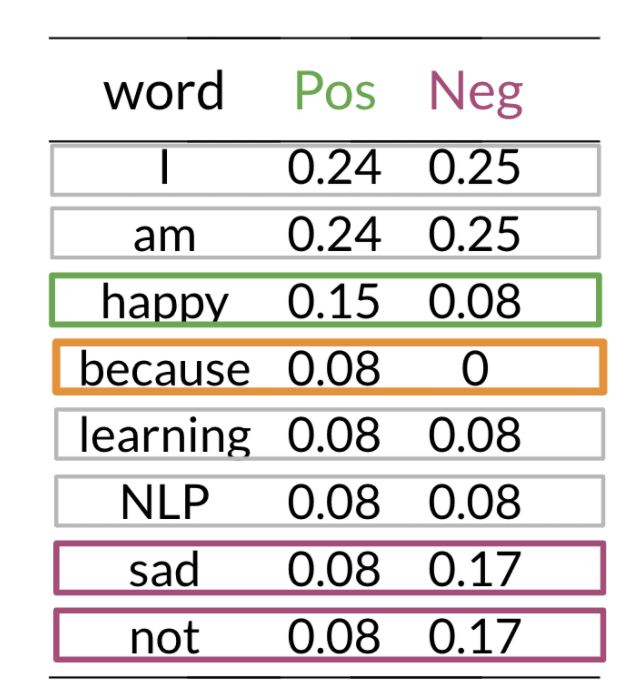
5. Apply Laplacian Smoothing to avoid P = 0
6. Compute Log likelihood - lambda
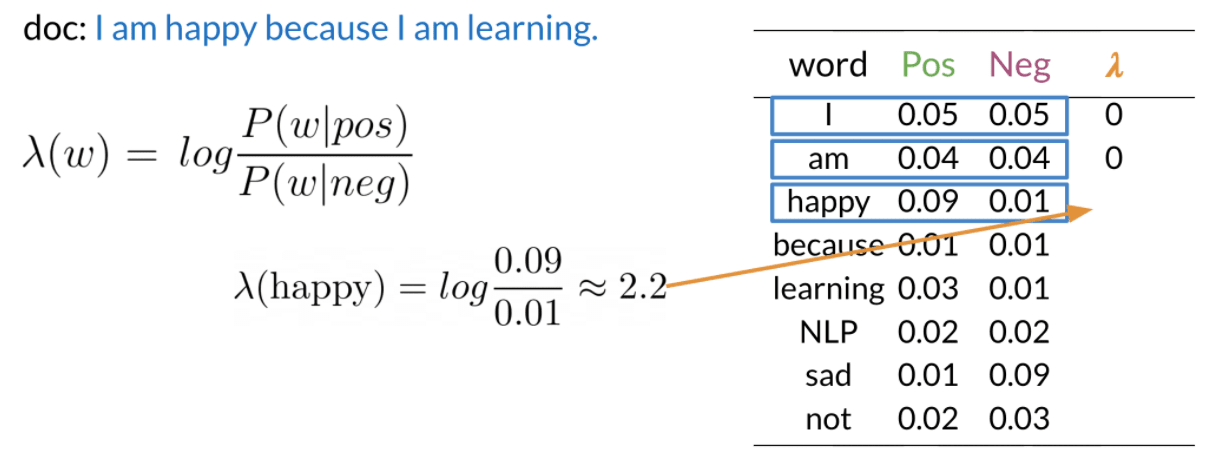
7. Compute log prior
The and correspond to number of positive and negative tweet
8. Made prediction
when prediction, we assume that the unknown word do not provide any information.
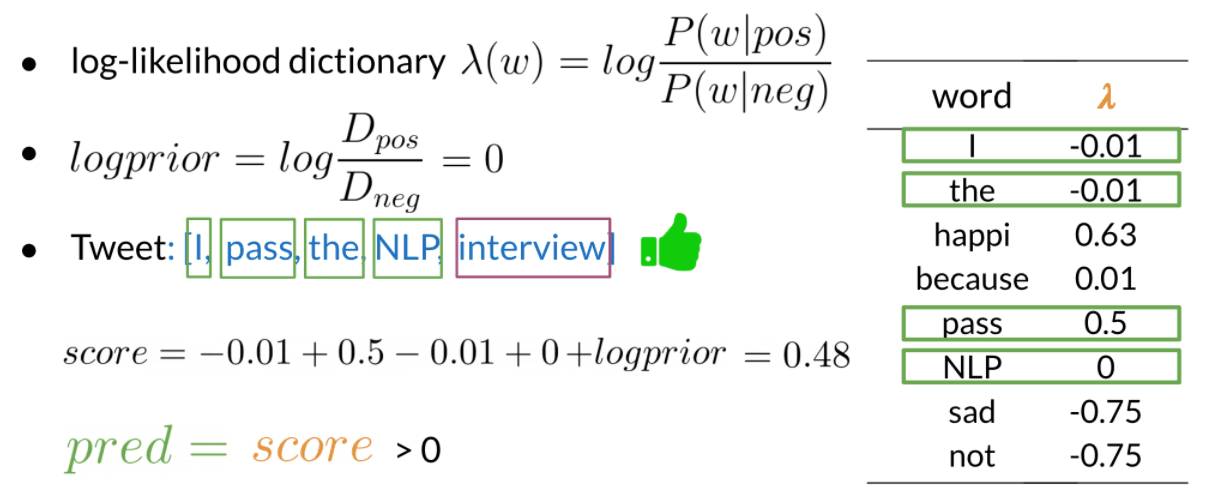
Assumptions
Independence assumption
It is always cold and snowy in __.
Naive Bayes assumes independence throughout. Furthermore, if you were to fill in the sentence on the right, this naive model will assign equal weight to the words "spring, summer, fall, winter".
Relative frequencies in corpus
In real word, there are much more positive tweets than negative. And the data could be much noisier.
Consideration
To speed up the prediction and training time, we might filter those word with neutral sentiment, that is filter based on the POS/NEG ratio.
Error Analysis
Removing punctuation and stop words
- I love learning 😦
- removing not making sentence being positive
Word order
- I am happy because I did not go
Adversarial attacks
- sarcasm, irony and Euphemisms
Example:
Tweet:
This is a ridiculously powerful movie. The plot was gripping and cried right through until the ending! processed tweet:
[ridicul, power, movi, plot, grip, cry, end] looks not good.
Vector Space Models
Instead of using The above 2 base model, a advance way is encoding words as vector. Encoding a text as a vector, Vector spaces are fundamental in many applications in NLP.
You can encode different relationship to get different performance.
- word by word (such as n-gram) and word by doc (the center word changed to a doc)
- The idea is encode word or doc using word frequency.
- if possible, you can try encode word using doc frequency, topic frequency etc.
Word Embedding (1) - PCA/SVD
A unsupervised-learning approach for getting word Embedding
STEPS:
1. Compute Window based Co-occurrence Matrix
Given following text, and window size being 3.
I enjoy flying。
I like NLP。
I like deep learning。
Get Co-occurrence matrix:
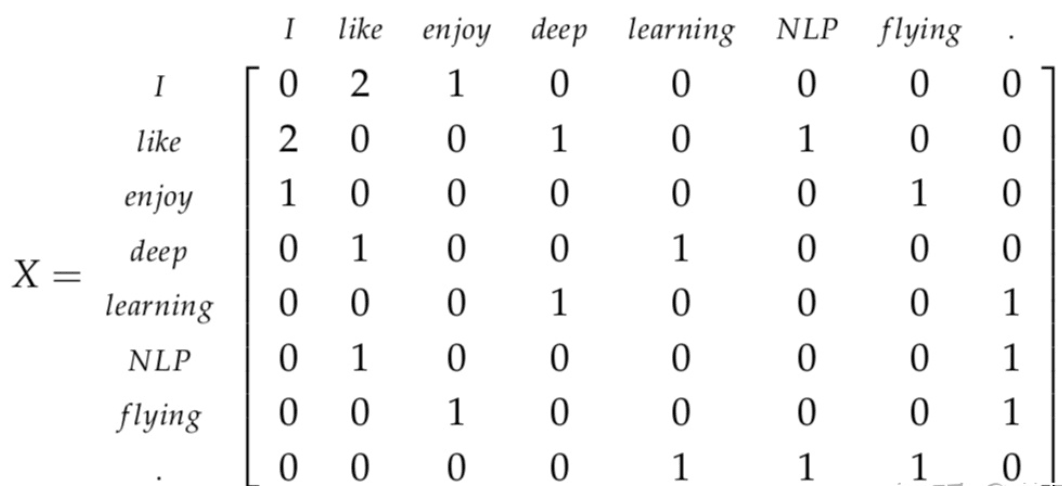
2. Apply SVD and select the first K columns
One of the method is usenp.linalg.SVD. the first k columns of matrix U is the word vectors (word embeddings).
3. If you use PCA instead of SVD, just do a mean Normalize data before perform SVD
Limitation
Large Memory needed for processing the high dimensional matrix.
Sparse Matrix
- High time complexity
High cost for updating the matrix.
- Variance for the word frequency.
Solution
- Filter stop words.
- use ramp window - (即基于在文档中词与词之间的距离给共现计数加上一个权值。)
- 使用皮尔逊相关系数将负数的计数设为 0,而不是使用原始的计数。
Application: Transforming word vectors
Following is a simple application of word vectors. i.e. Transform a English word into a Chinese word. A key idea is using hash function to speed up the algorithm.
STEPS
1. Using gradient decent to got a matrix R that transfer X into Y.
- Frobenius norm
2. Find the most similar word vector with Y.
there are two methods KNN and use hashing:
- KNN
using a KNN with k = 1, compute the distance between Y and all words. Time costly.
- Locality sensitive hashing
Hash based on the relative location of points and planes

def hash_multiple_plane(P_1, V)
"""
return the hash of V
"""
hash_value=0
for i, P in enumerate(P_1):
sign = side_of_plane(P,V)
hash_i =1 if sign >=0 else 0
hash value+=2**i* hash_i
return hash_value
Compute the hash value for Y, find the most similar vector with the same hash value.
Since the hash value depends on the planes, therefore, to get a robust result, multiple sets of random planes is used to find a combination set of neighbors.

Green, blue and orange are have same hash value with rad point in different set of planes. Search the nearest point among all of them. This can be used for fast document search
Autocorrect (for misspell)
A traditional way to do autocorrect is compute the word with n edit distance and take the top-k word with high probability. To speed, a greedy method is to compute the shortest edit distance. See below. The following steps only works for misspell check.
sample code here.
STEPS
1. Identify a misspelled word
When identifying the misspelled word, you can check whether it is in the vocabulary. If you don't find it, then it is probably a typo.
2. Compute Minimum Edit distance
- Levenshtein distance: Edit cost insert 1, delete 1, replace 2
Algorithm:
def edit_dist(s1, s2):
n1, n2 = len(s1), len(s2)
d = [[0] * (n2 + 1) for _ in range(n1 + 1)]
for i in range(n1 + 1):
d[i][n2] = n1 - i
for j in range(n2 + 1):
d[n1][j] = n2 - j
for i in range(n1 - 1, -1, -1):
for j in range(n2 - 1, -1, -1):
d[i][j] = min(d[i+1][j]+1, d[i][j+1]+1, d[i+1][j+1] + (s1[i] != s2[j]))
return d[0][0]
3. Filter Candidates
4. Calculate word probabilities
C: Number of times word appears
V: Total size of the corpus
Pick the one with largest probability.
Part of Speech Tagging (POS tagging)
the process of assigning a part of speech to a word. All probability you used is from the corpus you collect. For the POS tagging, how you train the states and how to label the data domain the result.
Sample code here
A algorithm to generate a sequence of word given a given sentence is the Viterbi Algorithm . It compute based on the Markov Chains and Hidden Markov Models
Data Processing
data format:
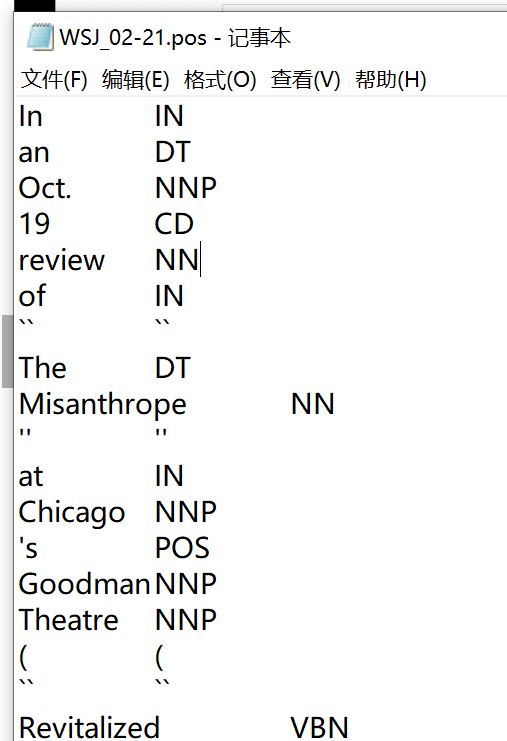
Hand labeled data, maintain the following information:
- word order
- word to tag
- start of new sentence
handling unknow words
- assign tag using suffix
- assign tag --unk--
Markov Chains
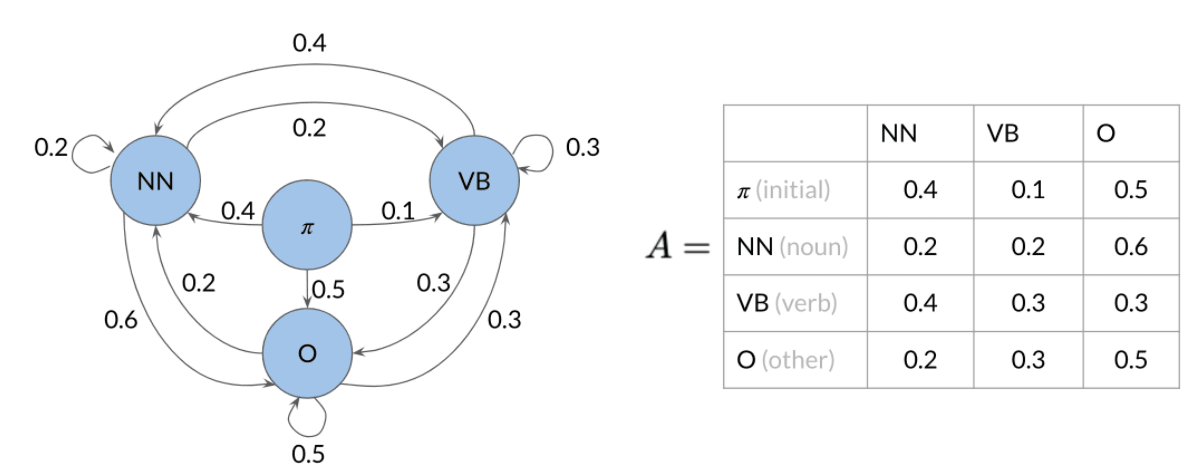
Computing the transition matrix A, Given states Q. This is based on your corpus.
Hidden Markov Models
Emission probabilities
The likelihood of a curtain each state yield a word
To get the emission probabilities:
1. Count the frequency of each word and Calculating probabilities
The is the count of times tag (i-1) shows up before tag i.
2. Smooth and avoid 0 probability.
3. Computing Emission matrix
The Viterbi Algorithm
STEPS
1. Initialization Probability Matrix C, previous action records: D

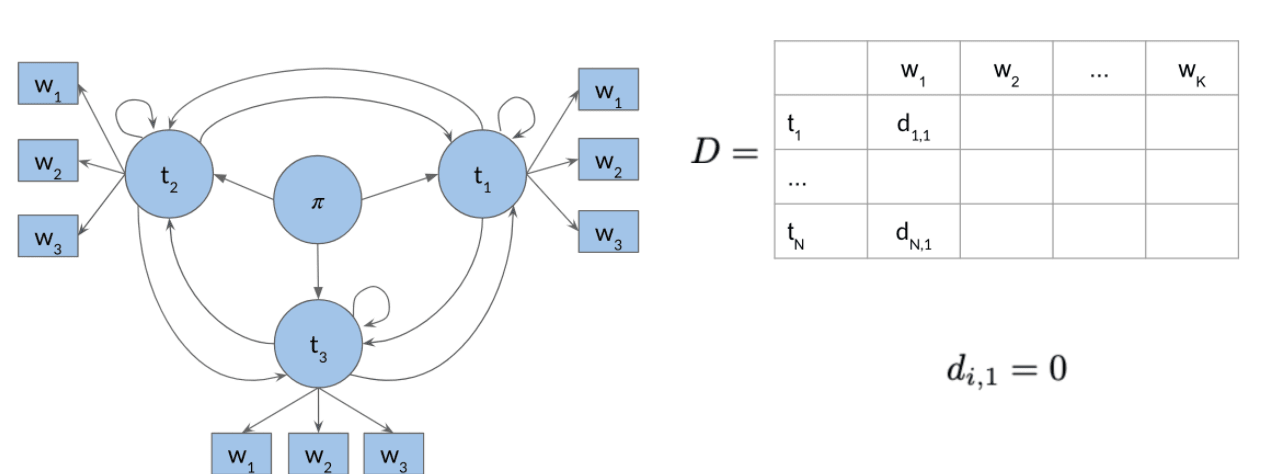
where B is the emission matrix of dimension (num_tags,len(vocab))
2. Forward pass
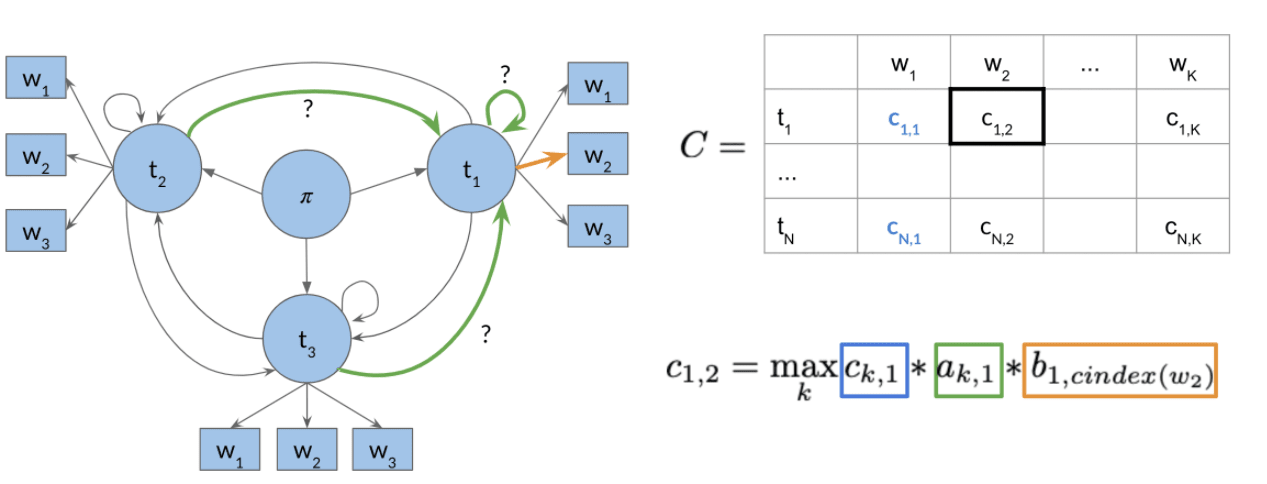
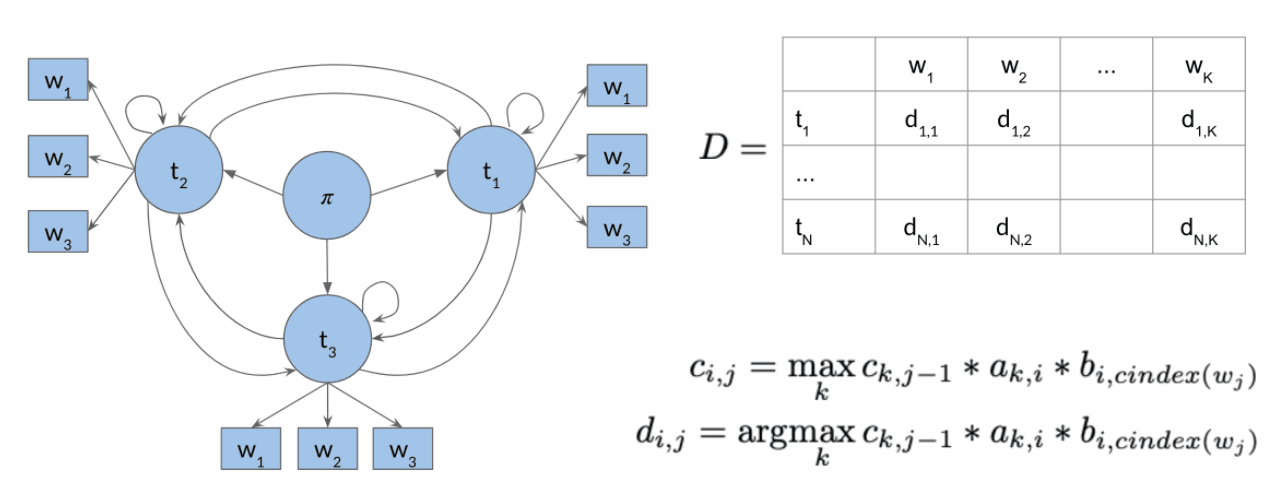
3. Backward pass
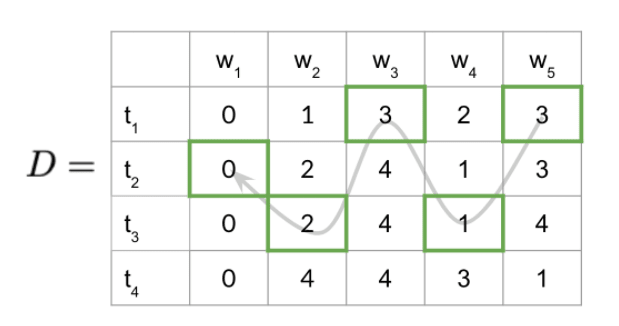
N-grams
N-grams are fundamental and give you a foundation that will allow you to understand more complicated models in the specialization. These models allow you to calculate probabilities of certain words happening in a specific sequence. Using that, you can build an auto-correct or even a search suggestion tool.
Prefix of N-gram
padding n-1 start token if you use n gram.
Bigram
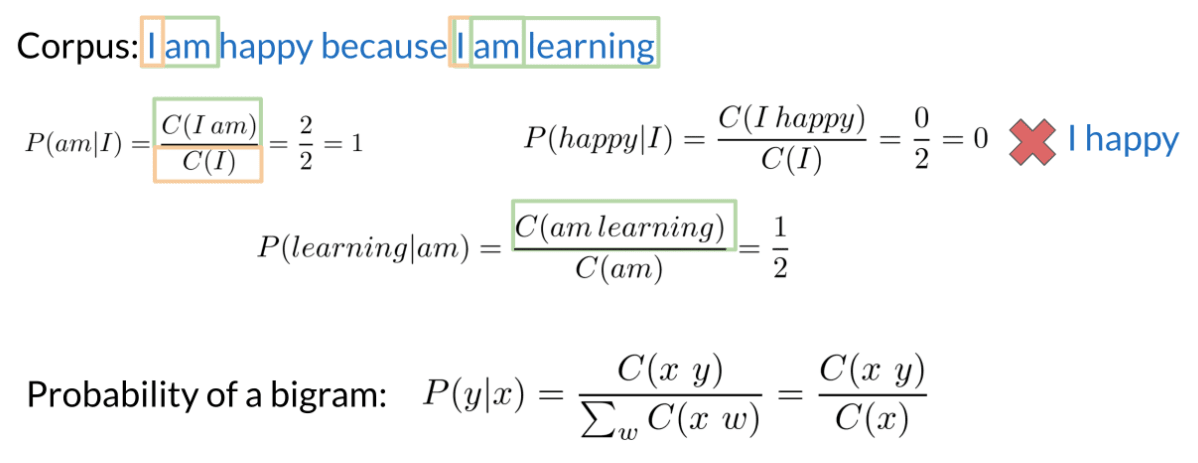
Probability of N-Grams:
Sequence probabilities should be:
However, under Markov assumption: only the last n words matters the next word. we can get the approximate sequence probabilities.
Starting and ending sentences <s> </s>
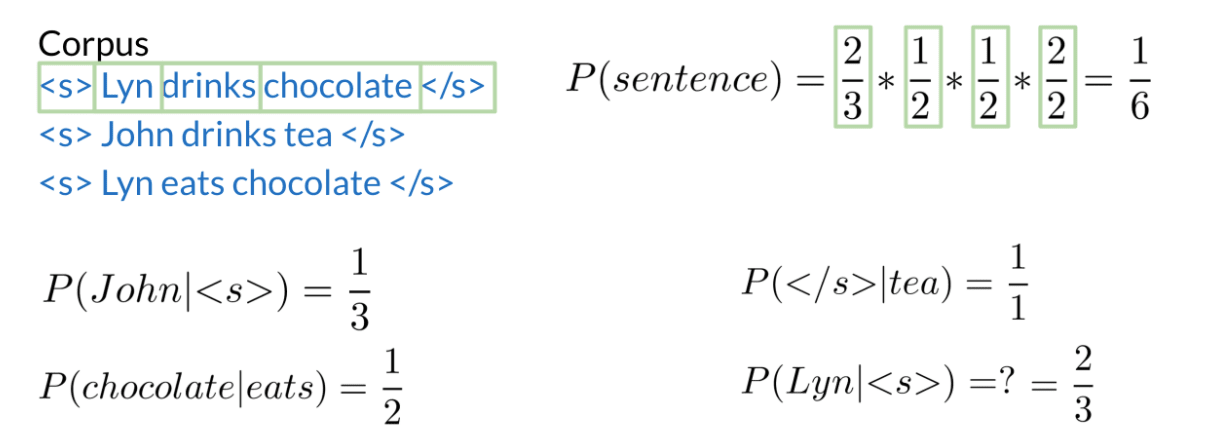

Limitation
- Large N-grams to capture dependencies between distant words
- Need a lot of space and RAM
Language Model Evaluation
Test data split method
(8/1/1 for small corpora or 98/1/1 for large)
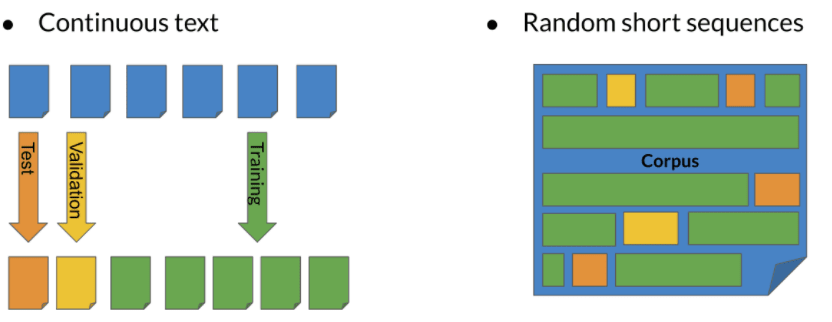
Perplexity
a text that is written by human is more likely to have a lower perplexity score
W: test set containing m sentences s The i-th sentence in the test set, each ending with</s> m: number of all words in entire test set W including </s> but not including <s>
Log perplexity:
Usually, a log PP between 4.3 - 5.9 is good.
def calculate_perplexity(sentence, n_gram_counts, n_plus1_gram_counts, vocabulary_size, k=1.0):
"""
Calculate perplexity for a list of sentences
Args:
sentence: List of strings
n_gram_counts: Dictionary of counts of n-grams
n_plus1_gram_counts: Dictionary of counts of (n+1)-grams
vocabulary_size: number of unique words in the vocabulary
k: Positive smoothing constant
Returns:
Perplexity score
"""
n = len(list(n_gram_counts.keys())[0])
sentence = ["<s>"] * n + sentence + ["<e>"]
sentence = tuple(sentence)
N = len(sentence)
product_pi = 1.0
for t in range(n, N):
n_gram = sentence[t-n:t]
word = sentence[t]
probability = estimate_probability(word, n_gram,
n_gram_counts, n_plus1_gram_counts, vocabulary_size, k=k)
product_pi *= probability
perplexity = product_pi**-(1/(N))
return perplexity
Out of Vocabulary OOV Words
- Create vocabulary V
- Min word frequency
- Max V size
Smoothing
4 methods to avoid N-gram probability being 0.
- Add-one smoothing (Laplacian smoothing)
this work only when vocabulary is large enough
- Add-k smoothing
- bach-off
- If N-gram missing => use (N-1)-gram, …: Using the lower level N-grams (i.e. (N-1)-gram, (N-2)-gram, down to unigram) distorts the probability distribution. Especially for smaller corpora, some probability needs to be discounted from higher level N-grams to use it for lower level N-grams.
- Probability discounting e.g. Katz backoff: makes use of discounting.
- “Stupid” backoff: If the higher order N-gram probability is missing, the lower order N-gram probability is used, just multiplied by a constant. A constant of about 0.4 was experimentally shown to work well
- interpolation
Word Embeddings
The task to create word embedding is self-supervised : it is both unsupervised in the sense that the input data — the corpus — is unlabelled, and supervised in the sense that the data itself provides the necessary context which would ordinarily make up the labels.
Methods Overview
Classical Methods
word2vec (Google, 2013)
Continuous bag-of-words (CBOW)**: the model learns to predict the center word given some context words.
Continuous skip-gram / Skip-gram with negative sampling (SGNS): the model learns to predict the words surrounding a given input word.
Global Vectors (GloVe) (Stanford, 2014): factorizes the logarithm of the corpus's word co-occurrence matrix, similar to the count matrix you’ve used before.
fastText (Facebook, 2016)**: based on the skip-gram model and takes into account the structure of words by representing words as an n-gram of characters. It supports out-of-vocabulary (OOV) words.
Deep learning, contextual embeddings
In these more advanced models, words have different embeddings depending on their context. You can download pre-trained embeddings for the following models.
BERT (Google, 2018):
ELMo (Allen Institute for AI, 2018)
GPT-2 (OpenAI, 2018)
CBOW
STEPS:
1. Processing data: Cleaning and Tokenization
- letter case
- Punctuation
- numbers -
<number> - special characters - emojy
2. Create Training set
The concept of window size is ok to be different.
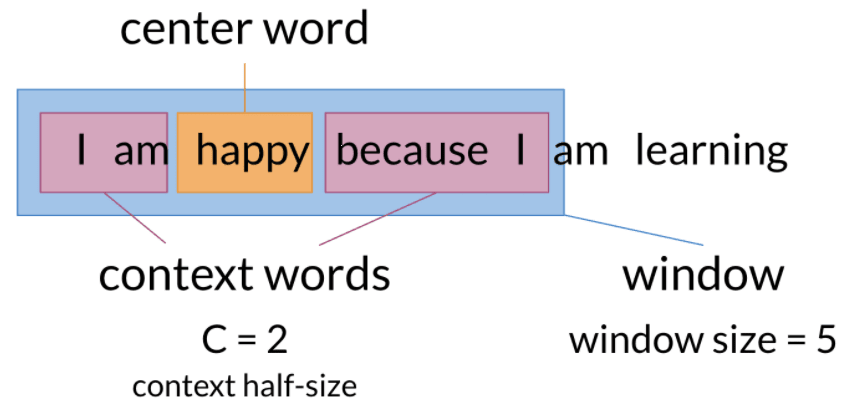
- CBOW takes the mean of context words , and used to predict the center word.
- to improve, weighted average is considered.
3. Building Model Architecture and Train

4. Extracting word embedding Vectors
3 different ways to get the word embedding

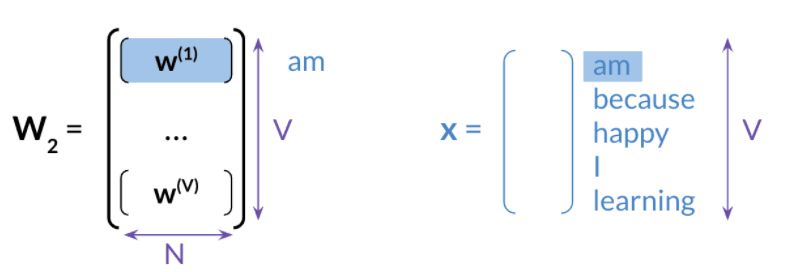

Back propagation
Skip-Gram
STEPS
1. Cleaning and Tokenizing
which is same with CBOW
2. Getting training set
sentence: The dog barked at the mailman
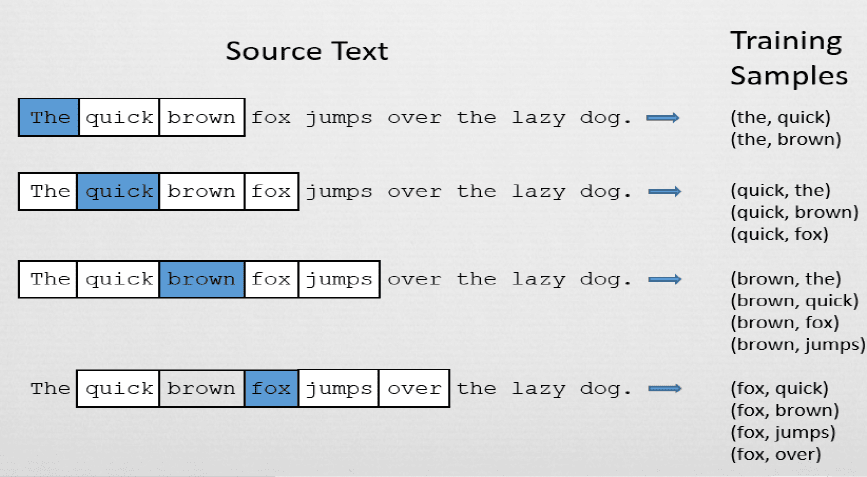
(The window size can be tune)
3. Training model
use the above training samples to train the following model. optimizing the cross entropy. the input and output word are represent as one hot vector.
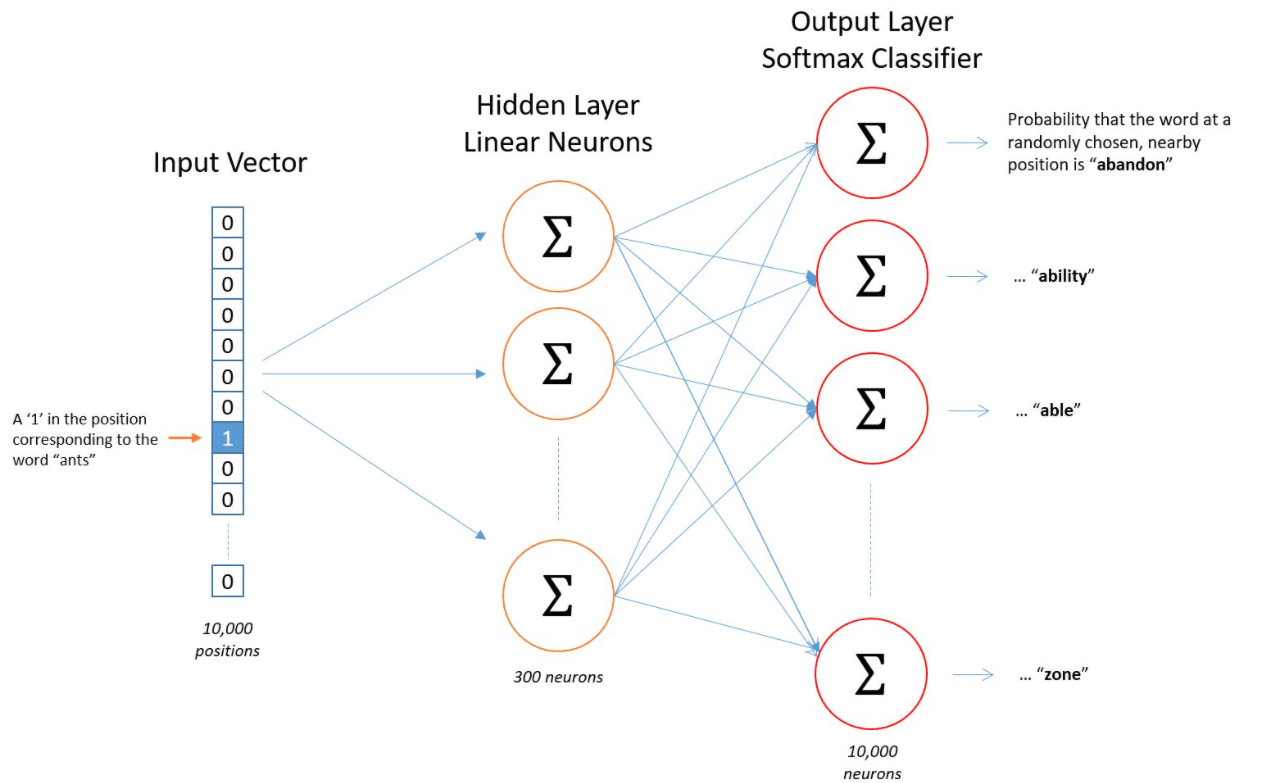
Size of hidden layer: the dimension of word vector usually being 100 to few thousand.
4. Extracting word embedding Vectors
Negative Sampling
Training set:
one positive sample:
{orange, juice}k negative sample:
{orange, king}etc- k = 5-20 for smaller data sets
- k = 2-5 for larger data set
Instead of training 10000 binary logistic classifier for the softmax layer, we are only train only 1+k samples of them.
Author recommend selecting negative examples with frequency of
Evaluating word Embeddings
Intrinsic Evaluation
- Analogies
“France” is to “Paris” as “Italy” is to ?> and also syntactic analogies as “seen” is to “saw” as “been” is to ?>.
- Clustering
- Visualization
Extrinsic Evaluation
tests word embeddings on external tasks like named entity recognition, parts-of-speech tagging, etc.
Evaluates actual usefulness of embeddings
Time-consuming
More difficult to troubleshoot
Neural Networks for Sentiment Analysis
Try different many-to-one architecture. In this sample code, a simple LSTM can perform better than the baseline model.
Hints
- Try Using Mean Layer after embedding layer
Named Entity Recognition
Named Entity Recognition (NER) locates and extracts predefined entities from text. It allows you to find places, organizations, names, time and dates.
Sample code here
Applications:
Search engine efficiency
Recommendation engines
Customer service
Automatic trading
Data Processing
- Convert words and entity classes into arrays:
- Pad with tokens: Set sequence length to a certain number and use the
<PAD>token to fill empty spaces, this token key will be used to mask the array when training.
Once you have that, you can assign each class a number, and each word a number.
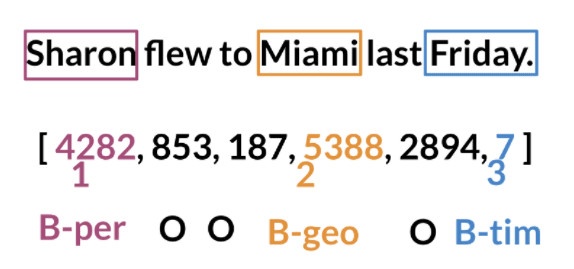
Siamese Networks
Application:
Handwritten checks
Question Duplicates [sample code]
Queries
Can do Voice checking?
Loss of siamese Networds
- Contrastive Loss
- Triplet loss Deep metric learning using Triplet network;
- Softmax loss:
- cosine loss,exp function, etc.
One Shot Learning
Compare with one shot learning, Classification got trouble when updating the classes.
STEPS
1. Prepare Batches
- Since we are going to use Hard negative mining, Sentence in the same batch should not be same meaning.
- sentence in both batch should have same meaning.
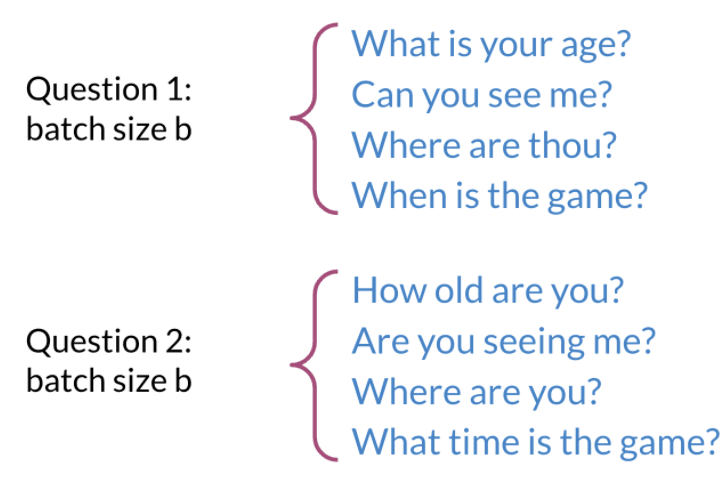
produce batches , where and are duplicate if and only if .
2. Build model and train
A simple Siamese Networks is shown here for learning purpose.

3. Testing
- The similarity of and determines the question similarity.
Hard Negative Mining
The Selection of samples determines the learning speed of the model because of the loss function we choose.
Full Cost:
- 𝜶: controls how far is from
- Easy negative triplet, little to learn: , the gradient will be 0.
- Semi-hard negative triplet:
- Hard negative triplet, more to learn:
Use hard Negative Mining to avoid this problem a bit. The steps is shown in the following:
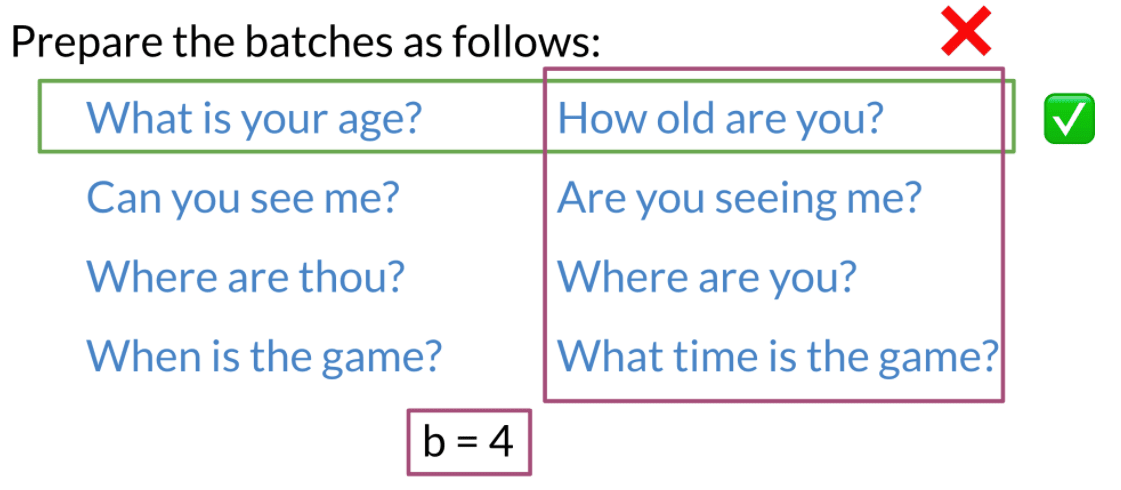
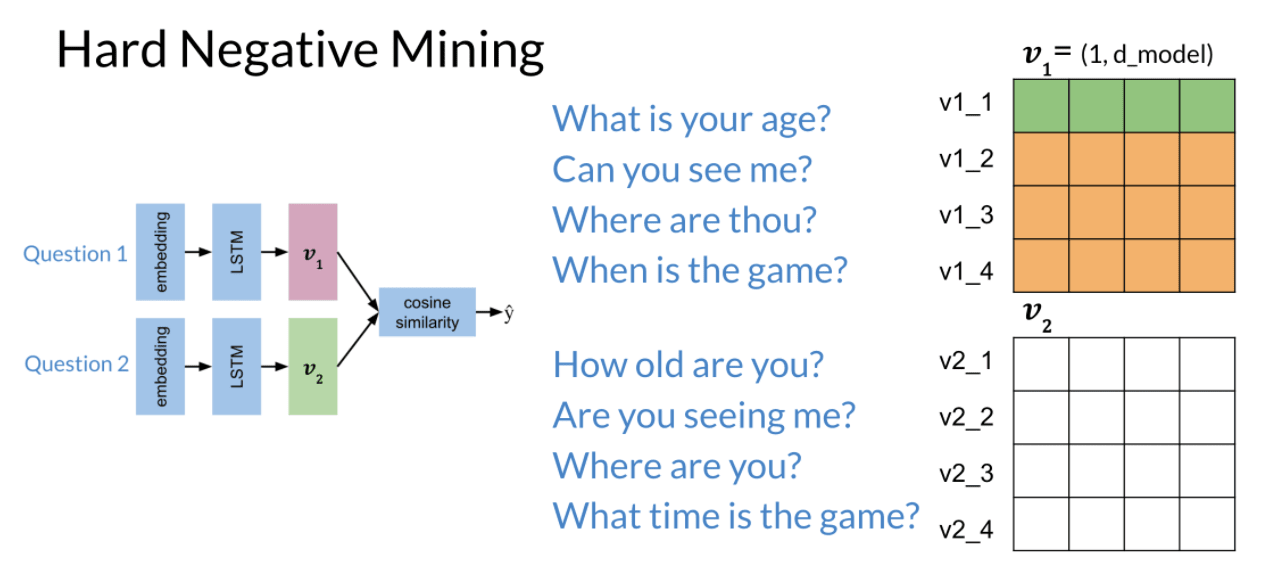
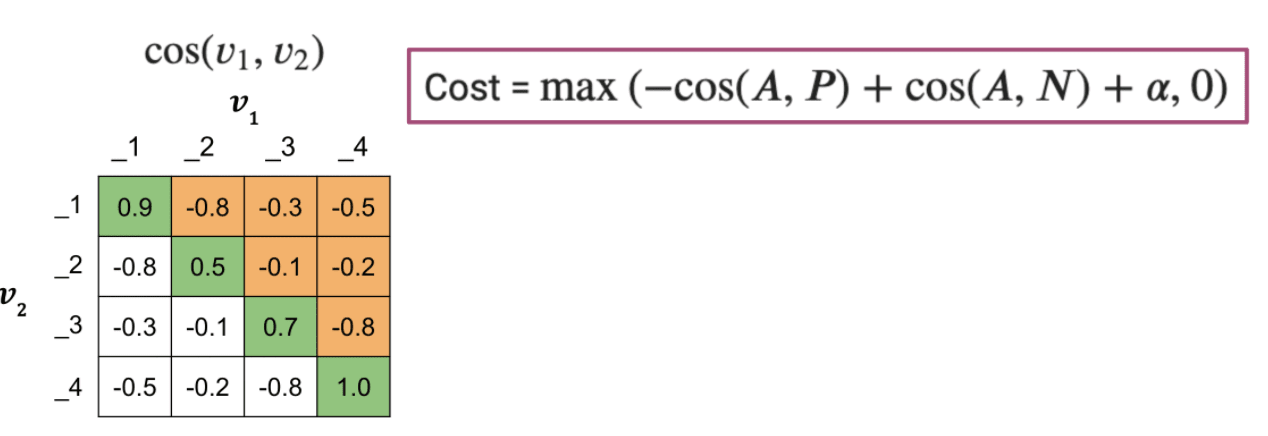
Use mean negative and closest negative cost to improve:
Reference
Note and Picture source: NLP specialization